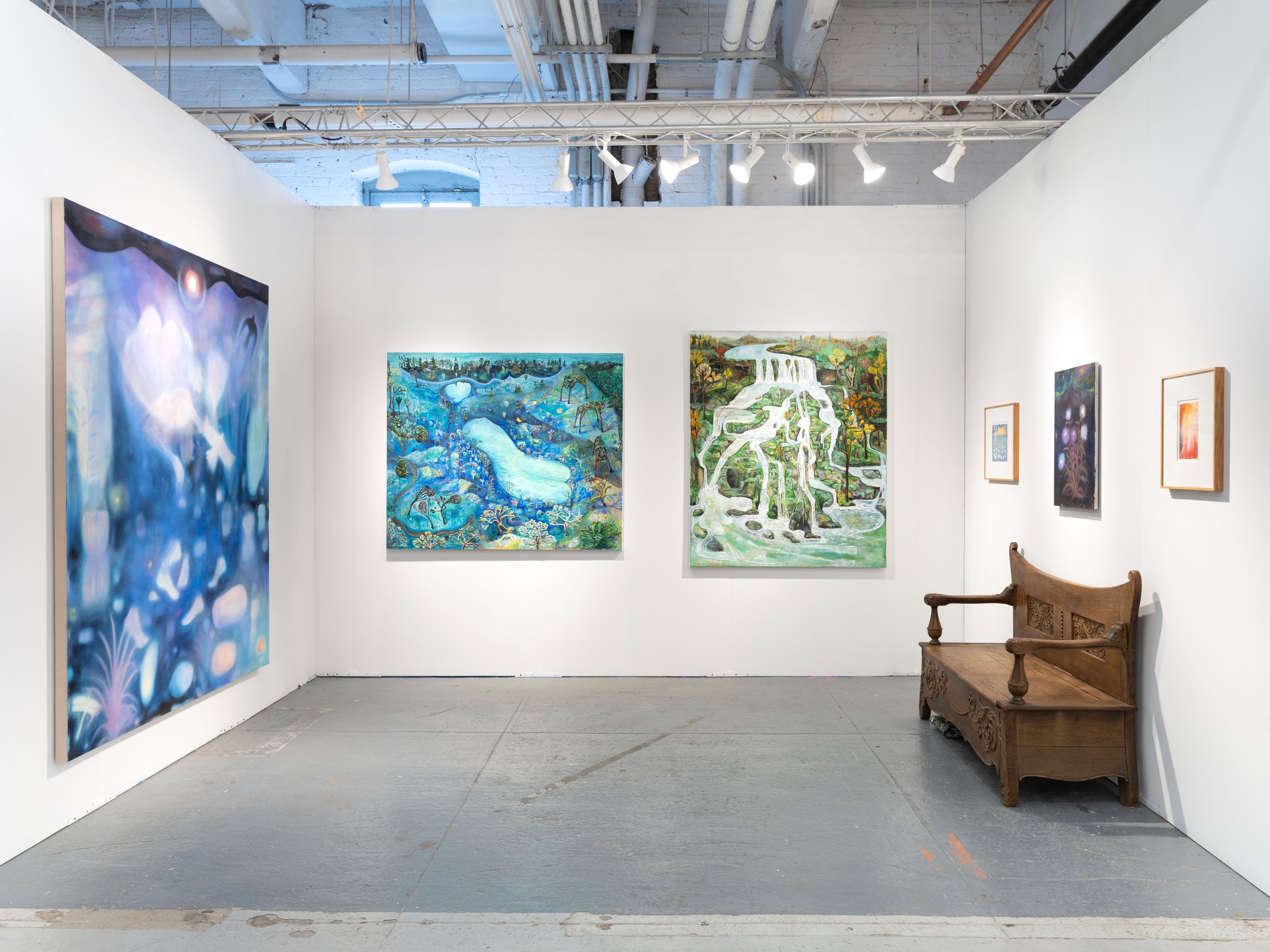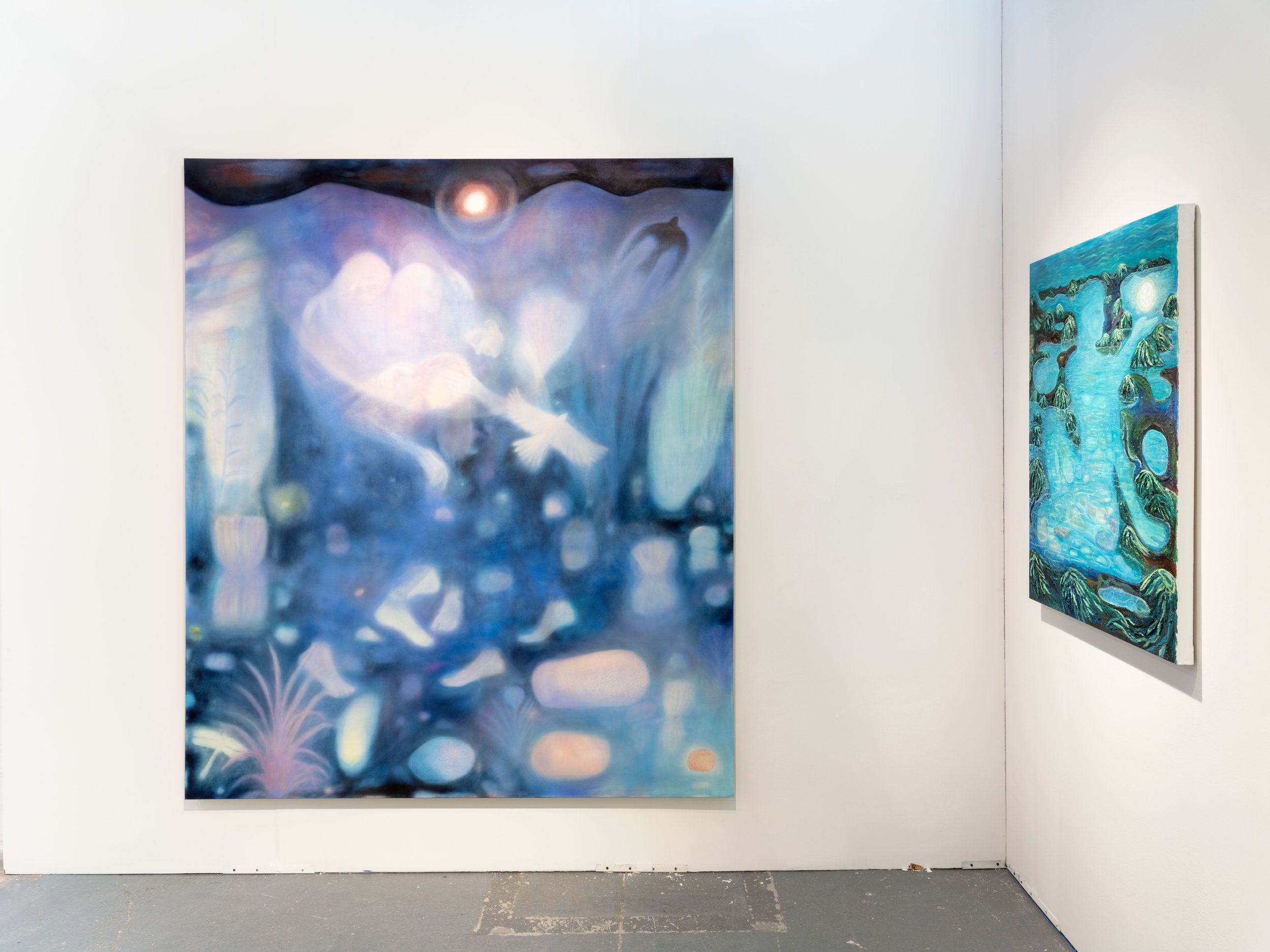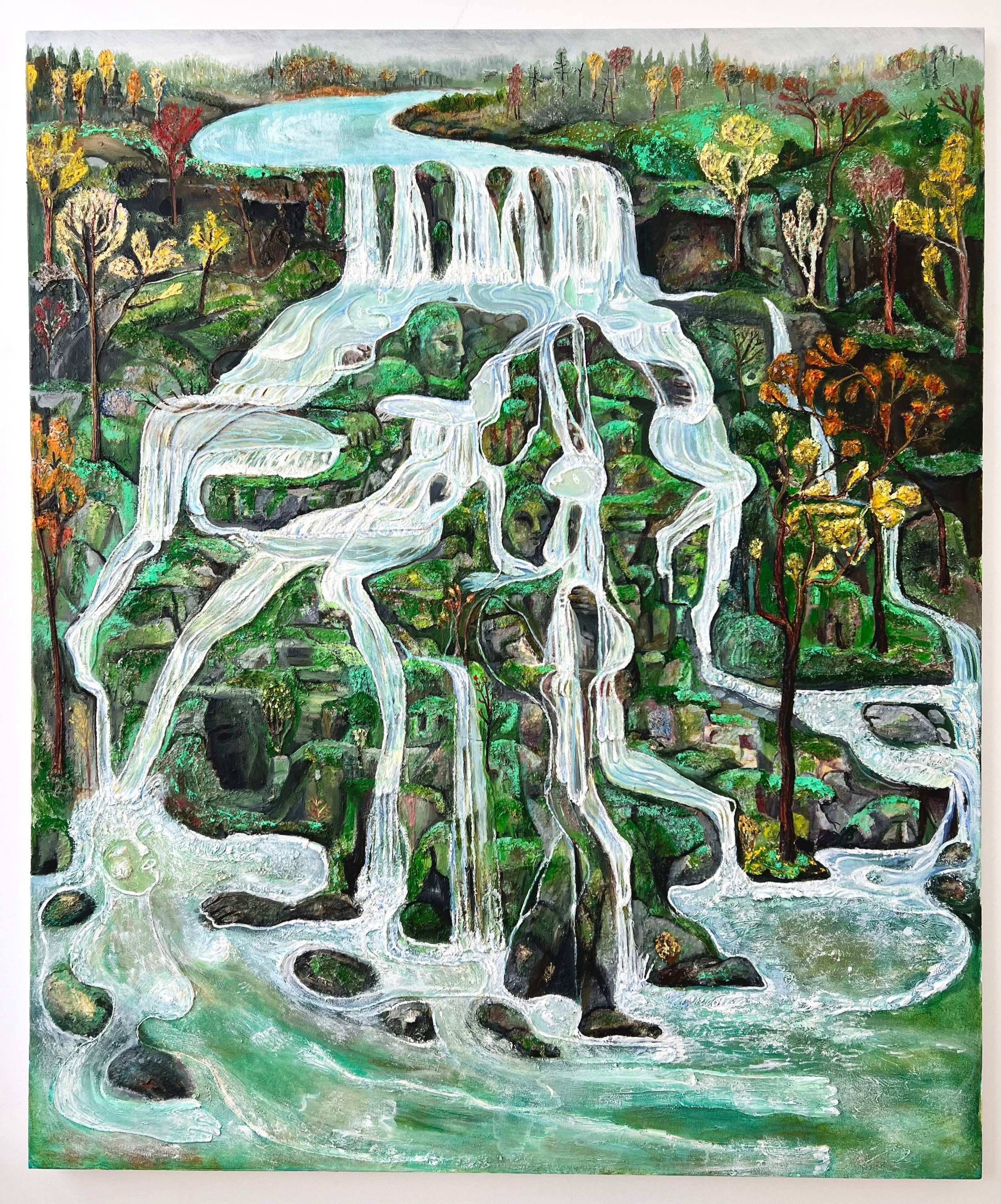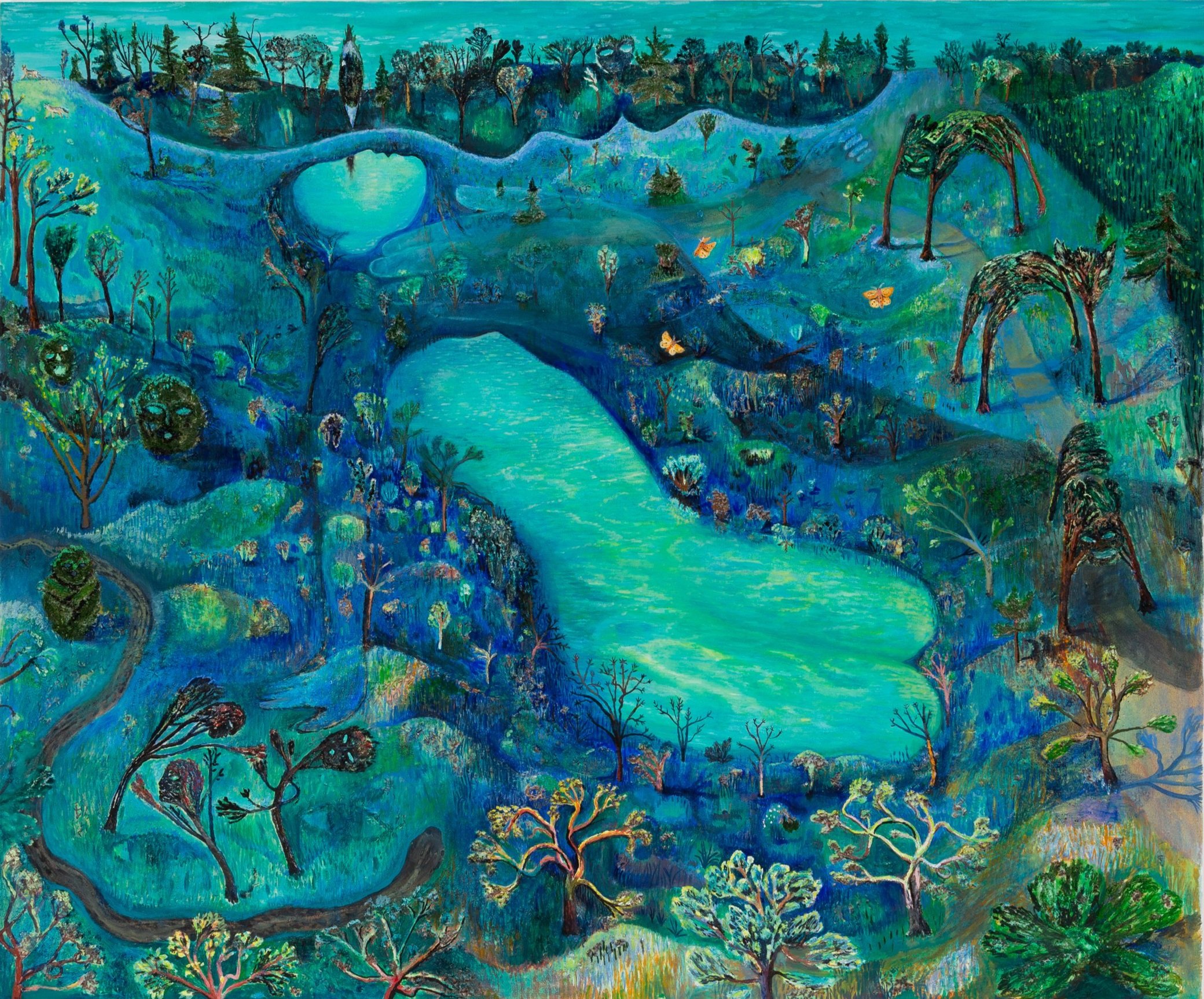NADA New York
May 18 - 21, 2023
Booth 4.16
𓇚
Sophia Heymans & Mary Herbert
with Moskowitz Bayse, Los Angeles
Sophia Heymans, Fallen Daughters, 2022. Paper mâché, molding paste, prairie grass seeds, mop strings, moss, oil on canvas, 60 x 50 x 1½ in.
The Valley is pleased to share new works by Sophia Heymans at NADA New York in a collaborative presentation with Mary Herbert and Moskowitz Bayse, Los Angeles.
Mutually invested in the potential for our felt and lived-in world to support and nurture alternatives to current systems and patterns, both Herbert and Heymans investigate spiritual internalities as the bases for formal observation and invention. Reconsidering diverse histories of figurative and landscape painting, both artists arrive at sympathetic positions: Heymans projects a world where the freed spirit of earth returns to its waters and mountains, while Herbert envisions a space in which eternal inner life-essences exist beyond bodily supports. The Valley and Moskowitz Bayse are excited to collaborate on a presentation that foregrounds these connections, as well as reveals latent elements of both artists’ practices.
Sophia Heymans (b. 1989, Minneapolis, MN) grew up on a family farm in Central Minnesota with her parents, sister, uncles, aunts and cousins. She was homeschooled throughout childhood, and became devoted to art-making from an early age. She earned a BFA in painting from Rhode Island School of Design in 2012, and is currently based in Brooklyn, New York. In her paintings she explores the relationship between the land and humankind, seeking to illuminate the personal, meaningful, and mystical relationship we have with the landscapes we inhabit. Confronting the weighted history of American landscape painting, Sophia’s paintings take a non-dominant perspective; a high horizon line unfurls to a deep foreground full of action, challenging notions of humankind's superiority over our environment. Playing on our natural inclination to see ourselves in nature, faces and bodies are revealed from highly textural underpaintings which make use of natural materials such as prairie grass seeds and moss. By painting humans as physically and psychologically intertwined with the environment so that you cannot differentiate between them, the artist seeks to reify the closeness that has been stripped from our relationship with the land by colonial and capitalist structures.
Heymans’ new body of work delves into two interconnected themes prevalent in memories of her childhood in Central Minnesota- femininity and water. Growing up in the land of ten thousand lakes, she came to understand herself and her gender identity through relationships to the bodies of water that comprised the landscape she lived in, and with the women she was surrounded by in her tight-knit family. Her practice often investigates highly personal memories and emotions overlayed on the landscapes where she experienced them. With this work, Sophia recalls feelings from different stages of her girlhood and womanhood: comfort and discomfort, joy and excitement, helplessness and guilt, insecurity and fear, power and freedom.
Reflecting on characteristics associated with femininity and the expression of these traits in water, Sophia created compositions from images of her female family members and friends, as well as historical artworks from many cultures that depict women as water. These observations have led to further exploration of the enmeshing of human form with landscape that she has become known for. In this series she anthropomorphizes bodies of water as female forms, personifying the characteristics of water that she has come to love and embody. Lessons of acceptance from the rain, independence from the river, and pleasure from the lakes. In these works she also explores the dangerous, resilient, and defiant powers of water- a sudden downpour, a too-strong current, a tendril of a waterfall that cannot be grasped by grabbing hands. Like femininity itself, water takes many forms, changes with the seasons and the weather, is never the same from one moment to the next, and we often see it for what it mirrors rather than for what it is. At once personal and universal, Sophia’s paintings ask us to explore what our relationship with our environment can teach us about ourselves.
Mary Herbert (b. 1988, London) works at the intersection of painting and drawing, making works that are intuitive explorations of memory and sensation. She creates subtle and enigmatic works which oscillate between the recognized and the unknown. Her current work is a series of dream-like paintings and soft pastels on paper formed of a composite of feelings, lived- sensation, unconscious processes and observation.
Herbert studied art at Goldsmiths College in London, where she developed a fascination with the materiality of the photographic image and it’s role in our collective lives as a container of memory or document of reality, and later at the Royal Drawing School where she re-connected with the physical and unconscious aspects of image making through drawing and painting. Her works have been the subject of solo exhibitions at the galleries Moskowitz Bayse (Los Angeles), Lychee One (London) and Arusha (Edinburgh), and have recently been included in group exhibitions at The British Museum, and the galleries Huxley Parlour (London), Harkawik (New York), and Clint Roenisch (Toronto), among others. Her work is in the collections of The British Museum and The Royal Collection.
Herbert’s recent paintings consider encryptions of meaning: the angle of a hand, the conspicuous lilt of a glowing flower, or the muted persistence of a mist-shrouded sun, contribute to the artist’s evocative painterly vocabulary. Herbert’s compositions suggest overlapping narratives of love, loss, and longing, while providing scant opportunities for their concrete decoding. Generously, though, her subjects radiate with emotional and spiritual potency as plants, bodies, and environments come alive with delight and pathos, both. The paintings’ layered, atmospheric surfaces reflect these charged emotional states, advancing the themes and formal strategies that marked Herbert’s earlier works–realized primarily in soft pastels on paper–and signaling new positions richly informed by classical sculpture, Symbolist and Transcendentalist painting, and more recent traditions of abstraction. Depicting sites of psychic unknowing, Herbert’s recent paintings lucidly describe the hazy emotional and spiritual conditions that inform our relationships, memories, and assessments of the self.




















